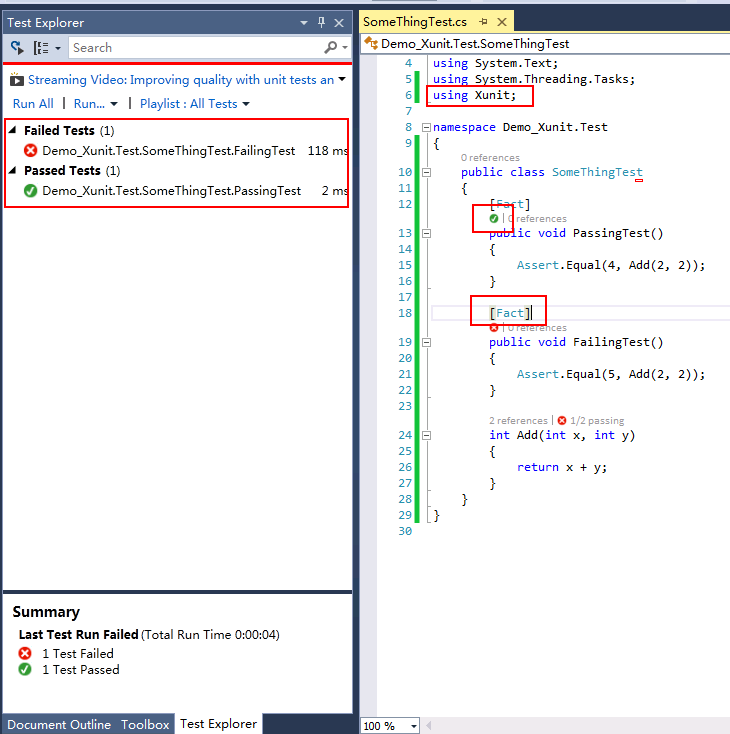Xunit和Nunit的区别
https://www.cnblogs.com/Leo_wl/p/5727712.html
舍弃Nunit拥抱Xunit
前言
今天与同事在讨论.Net下测试框架的时候,说到NUnit等大多数测试框架的SetUp以及TearDown方法并不是显得那么完美,所以在公司内部的项目中采用了Xunit框架。那么究竟是什么样的原因,让我们放弃了大多数框架都在用的Nunit或MSTest框架呢?
1. Xunit简介
首先奉上马丁大叔2006年对XUnit介绍的文章,http://www.martinfowler.com/bliki/Xunit.html。
Xunit其实是JUnit的衍生版,最开始是应用在Smalltalk中,其目的是支持持续集成,关于单元测试等相关内容可以参考我之前TDD系列文章,这里不做过多的介绍,只是介绍Why we choose Xunit。
GitHub地址:https://github.com/xunit/xunit
2. Xunit简单Demo
如此简单:

提示:需要通过NuGet下载xunit.net和xunit.visualstudio这两个安装包,然后启动“Test Explorer”运行测试,详情请参考这里。
3. Xunit对比Nunit的优点
这部分内容参考了官方文章以及一些自己对测试框架的场景的理解,如有错误之处,还请指出。
3.1 每个测试单一实例的讨论,SetUp以及TestFixtureSetUp
请参考马丁大师对单一实例的论述:http://martinfowler.com/bliki/JunitNewInstance.html,文章指出:对于测试缓存或每次测试之前重新实例化对象,这种做法是值得商榷的。虽然其有利于对象的调用,而且基本不用考虑对象回收的问题(仅当在TearDown中回收了资源),但这样仍然不符合绝对意义上的“对象隔离”原则。而且有些变量是只需全局实例化一次(在Nunit框架中要使用TestFeature创建),虽然这样也能满足需求,但是程序中还是有很多这种框架的特性需要熟悉,相比没有这些框架(指没有SetUp和TestFixtureSetUp)的语法来讲跟不方便一些,当然这些仅仅是一些思考。
同时,James Newkrik也在文章中提到,与其在SetUp中初始化更多的参数,破坏单一职责的原则,另外加上每回测试都要回顾SetUp和TearDown方法所执行的内容,倒不如将其放在Test内部,去掉SetUp和TearDown来增强测试的的表达性以及隔离性。
3.2 Xunit没有ExpectException
不采用Attribute的方式来捕捉异常有两方面的好处:
1. 在代码中直接断言(Assert)能捕捉到更多种类的异常。
2. 遵守Arrange-Act-Assert (or "3A") 模式:即测试命名上“范围-作用-断言”规范。
public class TestClass1
{
[ Fact ]
public void testException()
{
Assert .Throws< InvalidOperationException >(() => operation());
}
void operation()
{
throw new InvalidOperationException ();
}
}
3.3 Xunit更像面向切面的语言
Xunit中使用Fact、Theory、XxxData、Fact(Timeout=n)等标签来组织测试,从功能上讲更像切面编程。 请参考下一节。
3.4 Xunit去除了更多的Attribute
保留很少一部分标签有利于简化测试框架,加快熟悉测试框架的时间,使框架更为简洁、实用。
| NUnit 2.2 | MSTest | xUnit.net | Comments |
|---|---|---|---|
| [Test] | [TestMethod] | [Fact] | Marks a test method. |
| [TestFixture] | [TestClass] | n/a | xUnit.net does not require an attribute for a test class; it looks for all test methods in all public (exported) classes in the assembly. |
| [ExpectedException] | [ExpectedException] | Assert.Throws orRecord.Exception | xUnit.net has done away with the ExpectedException attribute in favor of Assert.Throws. SeeNote 1. |
| [SetUp] | [TestInitialize] | Constructor | We believe that use of [SetUp]is generally bad. However, you can implement a parameterless constructor as a direct replacement. See Note 2. |
| [TearDown] | [TestCleanup] | IDisposable.Dispose | We believe that use of[TearDown] is generally bad. However, you can implementIDisposable.Dispose as a direct replacement. See Note 2. |
| [TestFixtureSetUp] | [ClassInitialize] | IUseFixture<T> | To get per-fixture setup, implement IUseFixture<T> on your test class. See Note 3 |
| [TestFixtureTearDown] | [ClassCleanup] | IUseFixture<T> | To get per-fixture teardown, implement IUseFixture<T> on your test class. See Note 3 |
| [Ignore] | [Ignore] | [Fact(Skip="reason")] | Set the Skip parameter on the[Fact] attribute to temporarily skip a test. |
| n/a | [Timeout] | [Fact(Timeout=n)] | Set the Timeout parameter on the [Fact] attribute to cause a test to fail if it takes too long to run. Note that the timeout value for xUnit.net is in milliseconds. |
| [Property] | [TestProperty] | [Trait] | Set arbitrary metadata on a test |
| n/a | [DataSource] | [Theory], [XxxData] | Theory (data-driven test). SeeNote 4 |
3.4 Xunit使用IDisposable和IUseFixture<T>接口来代替显示声明SetUp和TestFixtureSetUp
首先,创建一个支持IDisposable对象:
using System;
using System.Configuration;
using System.Data.SqlClient;
public class DatabaseFixture : IDisposable
{
SqlConnection connection;
int fooUserID;
public DatabaseFixture()
{
string connectionString = ConfigurationManager.ConnectionStrings["DatabaseFixture"].ConnectionString;
connection = new SqlConnection(connectionString);
connection.Open();
string sql = @"INSERT INTO Users VALUES ('foo', 'bar'); SELECT SCOPE_IDENTITY();";
using (SqlCommand cmd = new SqlCommand(sql, connection))
fooUserID = Convert.ToInt32(cmd.ExecuteScalar());
}
public SqlConnection Connection
{
get { return connection; }
}
public int FooUserID
{
get { return fooUserID; }
}
public void Dispose()
{
string sql = @"DELETE FROM Users WHERE ID = @id;";
using (SqlCommand cmd = new SqlCommand(sql, connection))
{
cmd.Parameters.AddWithValue("@id", fooUserID);
cmd.ExecuteNonQuery();
}
connection.Close();
}
}
最后增加测试,并实现IClassFixture<DatabaseFixture>接口:
using System;
using System.Configuration;
using System.Data.SqlClient;
using Xunit;
public class ClassFixtureTests : IClassFixture<DatabaseFixture>
{
DatabaseFixture database;
public ClassFixtureTests(DatabaseFixture data)
{
database = data;
}
[Fact]
public void ConnectionIsEstablished()
{
Assert.NotNull(database.Connection);
}
[Fact]
public void FooUserWasInserted()
{
string sql = "SELECT COUNT(*) FROM Users WHERE ID = @id;";
using (SqlCommand cmd = new SqlCommand(sql, database.Connection))
{
cmd.Parameters.AddWithValue("@id", database.FooUserID);
int rowCount = Convert.ToInt32(cmd.ExecuteScalar());
Assert.Equal(1, rowCount);
}
}
}
从这里读者可能体会到,Xunit更多的利用了C#本身的一些特性,而非使用一些特殊的Attribute或者方法(例如SetUp),在设计哲学上更多的考虑了对象自动实现自我管理的机制,而非人为去管理,从某种意义上来讲,解除了部分依赖性,将部分功能交给程序C#本身处理,减少工作量。
4. 文章引用
Martin Flower介绍Xunit: http://www.martinfowler.com/bliki/Xunit.html
Xunit Github地址:https://github.com/xunit/xunit
Nunit 官方地址:http://www.nunit.org/
周公介绍Xunit:http://zhoufoxcn.blog.51cto.com/792419/1172320/
作者:Stephen Cui
出处:http://www.cnblogs.com/cuiyansong
版权声明:文章属于本人及博客园共有,凡是没有标注[转载]的,请在文章末尾加入我的博客地址。
如果您觉得文章写的还不错,请点击“推荐一下”,谢谢。





